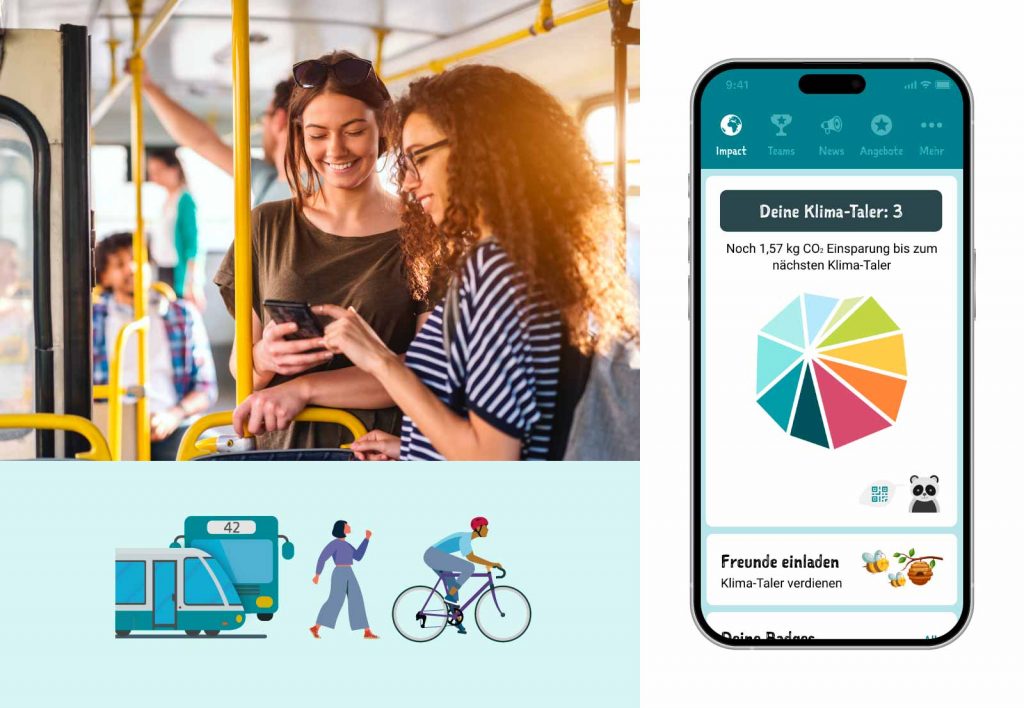The ecological handprint explained in brief

The ecological handprint describes the positive influence people can have on social structures through their actions, making climate-friendly behavior easier for many. While the carbon footprint shows how we can reduce our negative impact on the environment, the handprint focuses on actively initiating change—for example, through engagement at work, in schools, or in politics. It complements the footprint rather than replacing it. Those who increase their handprint help turn climate-friendly alternatives into new standards. In this way, individual actions generate collective impact, especially for municipal climate protection.
7 ways to increase your ecological handprint
The ecological handprint grows wherever people actively contribute to making sustainable behavior easier, more visible, or more commonplace for many. It is not just about individual consumption, but about initiating change in your environment: at school, in the workplace, in your neighborhood, or on social networks. Here are seven concrete ways you can practically increase your handprint:
Maximize your ecological handprint with the Klima-Taler app
The Klima-Taler app helps you leave the car behind more often, walk more, cycle, and use buses and trains. Your daily choices about how you get around and which routes you take also help improve your city’s planning. Through anonymized analyses, mobility needs can be better understood, preventing planning mistakes and unnecessary costs. Infrastructure can thus be adjusted in a data-driven way according to actual needs. In this way, your mobility choices become part of a larger change and inspire others to join in.

Get involved in envisioning and shaping car-free city centers
Whether you live in the city center, shop there, or travel by bike, anyone participating in traffic can contribute to discussions about the city’s transport planning. Write to your city administration, advocate for safe pedestrian and bike paths, or get involved in initiatives for car-free zones. The more voices support livable, low-emission, car-free city centers, the greater the structural change.
Increase your eco handprint through sustainable mobility
Organize bike events, ride-sharing programs, or public transport info days at your school, workplace, or in your neighborhood. You could, for example, start a “Bike-to-Work” month or advocate for more bike racks. Those who normalize sustainable mobility change the standards and increase their carbon handprint.
Establish climate-friendly eating habits in everyday life
Do you already eat vegan or vegetarian regularly? Extend this to larger groups: propose regular vegan days in your daycare, canteen, or community center. Or bring climate-friendly recipes into the next school project or neighborhood festival. With good ideas and direct options, sustainable eating becomes easier for others as well.
Make climate protection visible on social networks and in your neighborhood
Your knowledge, experience, and successes can motivate others. Share creative posts about sustainable fashion, climate-friendly mobility, or recycling on social media, or organize a small swap event and list it as an offer in the Klima-Taler app. Visibility creates normality and opens the door for change.
Integrate climate-friendly thinking into education and upbringing

As a parent, teacher, or engaged youth worker, you can introduce climate protection early and positively. An environmental project day, a shared raised garden bed, or participating in Klima-Taler challenges in the classroom shows that municipal climate protection is achievable and fun. This way, children learn at a young age how to increase their ecological handprint and keep their carbon footprint as small as possible.
Maximize the ecological handprint together
Change is easier as a team. Find like-minded people in your neighborhood, workplace, or club and carry out small projects together: from a sustainable holiday party to a bike repair day. Working together also allows you to advocate more effectively for political issues and steadily increase your ecological handprint.
Origin and development of the ecological handprint concept
The term ecological handprint was developed as a complement to the well-known carbon footprint and originates from the Indian environmental organization Centre for Environment Education (CEE). The idea arose from the desire to present climate protection not only as an individual sacrifice but also as active participation in shaping a sustainable future. Since then, the concept has been further developed internationally and is increasingly being integrated into educational work and civil society engagement. In German-speaking countries, the handprint is now also understood as a tool to motivate people not only to reflect but above all to take action. The focus is not on personal consumption behavior, but on the question: What can I do to make climate-friendly decisions easier for many?
Ecological handprint and carbon footprint are not competing models
Rather than positioning the concepts of the handprint and carbon footprint in opposition, it makes much more sense to leverage the advantages of both strategies. Our Klima-Taler app is a good example of how both concepts can be used effectively.
Users of the Klima-Taler app know that the climate currency is based on CO2 savings. Greenhouse gas emissions are a well-quantifiable measure for assessing environmental impact. This allows the climate impact—or climate-friendliness—of different modes of mobility and behaviors to be realistically evaluated and compared. In the app, users can see how their own carbon footprint increases or decreases based on their actions.
At the same time, the app is designed to increase the handprint. On one hand, it spreads the idea of climate protection through a playful concept; on the other hand, it helps create climate-friendly structures. For example, cities and municipalities can use movement data generated by the app to determine where increasing bus frequency or widening bike lanes would make sense, making the switch to green mobility easier for all residents. You can find more information and all features of the Klima-Taler app on the Klima-Taler website.
Summary of how you can increase your ecological handprint
Those who want to increase their ecological handprint don’t need to be a perfect role model around the clock, but they do need to be willing to take action. Wherever your commitment inspires others or changes structures, your actions are multiplied. Every measure counts, especially when it influences many people. For example, advocating for car-free or traffic-calmed city centers can be an important step toward promoting healthy, climate-friendly mobility for everyone. Even within your school, workplace, or club, ensuring that vegan or vegetarian meal options are regularly available creates a lasting impact. Digital tools like the Klima-Taler app can further help make climate-friendly behavior visible and encourage it on a larger scale. This is an example of how personal commitment can trigger structural change.
Do you want your municipality to become part of the Klima-Taler network?
Then get in touch with us or download the letter to the climate protection officers of your city or municipality.
If you succeed in advancing municipal climate protection in this way, you will have significantly increased your ecological handprint.

Markus Schulz
m.schulz@changers.com

